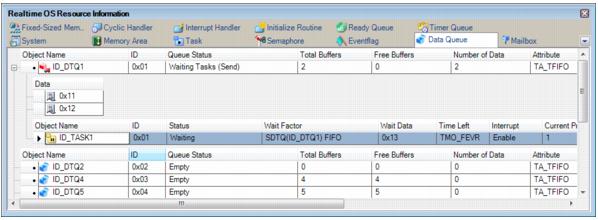This tab displays the data queue information (e.g. Data Queue Name and ID) of the RI78V4.
Figure A-9. [Data Queue] Tab
The following items are explained here.
- From the [Debug] menu, select [Download].
- From the [View] menu, select [Realtime OS] >> [Resource Information].
[Description of each area]
(1) Information display area
This layer displays the data queue information (e.g. Data Queue Name and ID) of the RI78V4.
This layer consists of the following items.
|
|
An icon indicating the current status of the data queue and the name of the data queue are shown in the following format.
Note that if the name of the data queue is undefined, the name will appear as "ID".
|
|
|
There are queued tasks (sending waiting tasks).
|
|
|
There are queued tasks (receiving waiting tasks).
|
|
|
There are queud data (receiving waiting data).
|
|
|
There are no queued tasks/data (waiting tasks/receiving waiting data).
|
|
|
The ID of the data queue is shown.
|
|
|
The current status of the data queue is shown.
|
|
|
There are queued tasks (sending waiting tasks).
|
|
|
There are queued tasks (receiving waiting tasks).
|
|
|
There are queud data (receiving waiting data).
|
|
|
There are no queued tasks/data (waiting tasks/receiving waiting data).
|
|
|
Displays the maximum number of data buffers that can be queued.
|
|
|
Displays the number of free buffers in the data queue.
The number of free buffers is the total number of buffers minus the number of buffers receiving waiting data.
|
|
|
Displays the number of data in buffers.
|
|
|
Displays the queuing method of the sending waiting tasks.
If the queuing method of the receiving waiting tasks is "data reception request order", then the queuing method of the receiving waiting data will be "data send request order".
|
|
|
|
|
|
|
<1> Sending waiting task/receive waiting task information
The sending/receiving waiting task information (e.g. Task Name and ID) only appears if there are tasks queued in the data queue's wait queue.
See the
[Task] tab for details about sending/receiving waiting task information.
Figure A-10. [Data Queue] Tab (Sending Waiting Task Information)
Figure A-11. [Data Queue] Tab (Receiving Waiting Task Information)
Remarks 1.
If the sending waiting task and receiving waiting task information (Task Name , ID etc) in each cell is double clicked, then Editor panel displays the source file of the task, and the caret moves to the corresponding location.
2. If the
sending waiting task and receiving waiting task information (Current Task SP, Task stack area) in the cell is double clicked, then Memory panel displays the contents of the task stack, and the caret moves to the corresponding location.
<2> Receiving waiting data information
The receiving waiting data information (e.g. Data) only appears if there are data queued in the data queue.
Figure A-12. [Data Queue] Tab (Receiving Waiting Data Information)
This area consists of the following items.
|
|
the contents of the data is shown.
|
The context menu displayed in response to a right mouse click differs as follows depending on the area clicked.
|
|
Displays cascade menus for selecting the header items to display.
|
|
|
|
The following items are displayed for selection.
Data Queue Name, ID, Queue Status, Total Buffers, Free Buffers, Number of Data, Attribute
|
|
|
The item in question will be displayed.
|
|
|
The item in question will not be displayed.
|
|
|
Displays cascade menus for selecting the display notation.
|
|
|
|
The following items are displayed for selection.
ID, Total Buffers, Free Buffers, Number of Data
|
|
|
Displays value in signed decimal number.
|
|
|
Displays value in hexadecimal number.
|
|
|
Resets the display item (e.g. whether or not to display header items, display notation, display order and display width).
|



